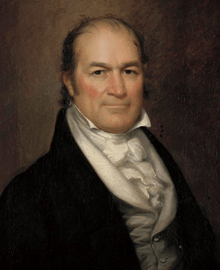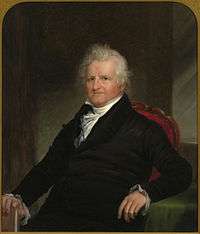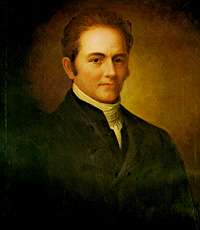13th United States Congress
| 13th United States Congress | |||||||||||||||||||||||||||||
| |||||||||||||||||||||||||||||
The Thirteenth United States Congress was a meeting of the legislative branch of the United States federal government, consisting of the United States Senate and the United States House of Representatives. It met in Washington, D.C. from March 4, 1813, to March 4, 1815, during the fifth and sixth years of James Madison's presidency. The apportionment of seats in the House of Representatives was based on the Third Census of the United States in 1810. Both chambers had a Democratic-Republican majority. The first two sessions were held at the Capitol building while the third, convened after the Burning of Washington, took place in the First Patent Building.
Major events

- September 10, 1813: War of 1812: Battle of Lake Erie
- October 5, 1813: War of 1812: Battle of the Thames
- March 27, 1814: Creek War: Battle of Horseshoe Bend
- July 25, 1814: War of 1812: Battle of Lundy's Lane
- August 25, 1814: War of 1812: Burning of Washington
- September 11, 1814: War of 1812: Battle of Lake Champlain
- September 13, 1814: War of 1812: Bombardment of Fort McHenry at Baltimore
- November 7, 1814: War of 1812: Forces under Gen. Andrew Jackson seized Pensacola
- November 23, 1814: Vice President Elbridge Gerry died
- December 15, 1814: Hartford Convention convened through January 5, 1815, in which New England Federalists met to discuss their grievances concerning the ongoing War of 1812 and the political problems arising from the federal government's increasing power. Despite radical outcries among Federalists for New England secession and a separate peace with Great Britain, moderates outnumbered them and extreme proposals were not a major focus of the debate.
- December 24, 1814: War of 1812: Treaty of Ghent signed
- January 8, 1815: War of 1812: Battle of New Orleans
Major legislation
Treaties ratified
- February 17, 1815: War of 1812: Senate ratified the Treaty of Ghent, 8 Stat. 218
Party summary
The count below identifies party affiliations at the beginning of the first session of this congress. Changes resulting from subsequent replacements are shown below in the "Changes in membership" section.
Senate
| Party (shading shows control) |
Total | Vacant | ||
|---|---|---|---|---|
| Democratic- Republican (DR) |
Federalist (F) | |||
| End of the previous congress | 30 | 6 | 36 | 0 |
| Begin | 27 | 6 | 33 | 3 |
| End | 24 | 11 | 35 | 1 |
| Final voting share | 68.6% | 31.4% | ||
| Beginning of the next congress | 21 | 12 | 33 | 3 |
House of Representatives
Following the 1810 census, the size of the House was increased to 182 seats from 142.
| Party (shading shows control) |
Total | Vacant | ||
|---|---|---|---|---|
| Democratic- Republican (DR) |
Federalist (F) | |||
| End of the previous congress | 105 | 36 | 141 | 1 |
| Begin | 108 | 68 | 176 | 6 |
| End | 115 | 67 | 182 | 0 |
| Final voting share | 63.2% | 36.8% | ||
| Beginning of the next congress | 131 | 46 | 177 | 5 |
Leadership
Senate
- President: Elbridge Gerry (DR), until November 23, 1814; thereafter vacant.
- President pro tempore: William H. Crawford (DR), March 4, 1813 – March 23, 1813
- Joseph B. Varnum (DR), December 6, 1813 – February 3, 1814
- John Gaillard (DR), from November 25, 1814
House of Representatives
- Speaker: Henry Clay (DR), to January 19, 1814
- Langdon Cheves, (DR), from January 19, 1814
Members
This list is arranged by chamber, then by state. Senators are listed by seniority, and Representatives are listed by district.
Senate
Senators were elected by the state legislatures every two years, with one-third beginning new six-year terms with each Congress. Preceding the names in the list below are Senate class numbers, which indicate the cycle of their election. In this Congress, Class 1 meant their term ended with this Congress, requiring reelection in 1814; Class 2 meant their term began in the last Congress, requiring reelection in 1816; and Class 3 meant their term began in this Congress, requiring reelection in 1818.
Connecticut
Delaware
Georgia
Kentucky
Louisiana
Maryland
Massachusetts
New Hampshire
New Jersey
|
New York
North Carolina
Ohio
Pennsylvania
Rhode Island
South Carolina
Tennessee
Vermont
Virginia
|
House of Representatives
ConnecticutAll representatives were elected statewide on a general ticket.
DelawareBoth representatives were elected statewide on a general ticket.
GeorgiaAll representatives were elected statewide on a general ticket.
Kentucky(10 Democratic-Republicans)
Louisiana(1 Democratic-Republican)
MarylandThe 5th district was a plural district with two representatives.
Massachusetts(16-4 Democratic-Republican)
New HampshireAll representatives were elected statewide on a general ticket.
New JerseyThere were three plural districts, each had two representatives each.
New YorkThere were six plural districts, the 1st, 2nd, 12th, 15th, 20th & 21st, each had two representatives.
|
North Carolina(10-3 Democratic-Republican)
Ohio(6 Democratic-Republicans)
PennsylvaniaThere were six plural districts, the 2nd, 3rd, 5th, 6th & 10th had two representatives each, the 1st had four representatives.
Rhode IslandBoth representatives were elected statewide on a general ticket.
South Carolina(9 Democratic-Republicans)
Tennessee(6 Democratic-Republicans)
VermontAll representatives were elected statewide on a general ticket.
Virginia(17-6 Democratic-Republican)
Non-voting delegates(no representation)
|
Changes in membership
The count below reflects changes from the beginning of the first session of this Congress.
Senate
- replacements: 9
- Democratic-Republicans: 2 seat net loss
- Federalists: 2 seat net gain
- deaths: 2
- resignations: 10
- interim appointments: 3
- vacancies: 3
- Total seats with changes: 15
| State (class) |
Vacator | Reason for change | Successor | Date of successor's formal installation |
|---|---|---|---|---|
| New Hampshire (3) |
Vacant | Legislature had failed to elect a Senator. Successor was appointed April 2, 1813 to continue the term. |
Charles Cutts (DR) | Appointed April 2, 1813 |
| Maryland (3) |
Vacant | Legislature had failed to elect a Senator. Successor was elected late May 21, 1813 to finish the term. |
Robert H. Goldsborough (F) | Seated May 21, 1813 |
| Delaware (2) |
Vacant | James A. Bayard (F) resigned at the end of the previous Congress. Successor elected May 28, 1813 to finish the term. |
William H. Wells (F) | Seated May 28, 1813 |
| Georgia (2) |
William H. Crawford (DR) | Resigned March 23, 1813. Successor appointed April 8, 1813, to continue the term. |
William Bulloch (DR) | Seated April 8, 1813 |
| Connecticut (3) |
Chauncey Goodrich (F) | Resigned May 1813 to become Lieutenant Governor of Connecticut. Successor elected May 13, 1813, to finish the term. |
David Daggett (F) | Seated May 13, 1813 |
| Massachusetts (1) |
James Lloyd (F) | Resigned May 1, 1813. Successor elected May 5, 1813. |
Christopher Gore (F) | Seated May 5, 1813 |
| New Hampshire (3) |
Charles Cutts (DR) | Interim appointee was not elected. Successor elected June 10, 1813. |
Jeremiah Mason (F) | Seated June 10, 1813 |
| Georgia (2) |
William Bulloch (DR) | Interim appointee was not elected to finish the term. Successor elected November 6, 1813 to finish the term. |
William W. Bibb (DR) | Seated November 6, 1813 |
| Tennessee (2) |
George W. Campbell (DR) | Resigned February 11, 1814 after being appointed US Secretary of the Treasury. Successor appointed March 17, 1814, to continue the term. |
Jesse Wharton (DR) | Seated March 17, 1814 |
| Pennsylvania (1) |
Michael Leib (DR) | Resigned February 14, 1814 after becoming Postmaster of Philadelphia. Successor elected February 24, 1814, to finish term. |
Jonathan Roberts (DR) | Seated February 24, 1814 |
| New Hampshire (2) |
Nicholas Gilman (DR) | Died May 2, 1814. Successor elected June 24, 1814, to finish the term. |
Thomas W. Thompson (F) | Seated June 24, 1814 |
| Kentucky (2) |
George M. Bibb (DR) | Resigned August 23, 1814. Successor appointed August 30, 1814, to continue the term. |
George Walker (DR) | Seated August 30, 1814 |
| Ohio (1) |
Thomas Worthington (DR) | Resigned December 1, 1814 after being elected Governor. Successor elected December 10, 1814, to finish the term ending. |
Joseph Kerr (DR) | Seated December 10, 1814 |
| Kentucky (2) |
George Walker (DR) | Interim appointee was not elected to finish term. Successor elected December 16, 1814 to finish term. |
William T. Barry (DR) | Seated December 16, 1814 |
| North Carolina (3) |
David Stone (DR) | Resigned December 24, 1814. Successor elected December 24, 1814, to finish the term, but failed to qualify. |
Francis Locke, Jr. | Never seated for failing to qualify |
| Kentucky (3) |
Jesse Bledsoe (DR) | Resigned December 24, 1814. Successor elected February 2, 1815, to finish the term. |
Isham Talbot (DR) | Seated February 2, 1815 |
| Virginia (1) |
Richard Brent (DR) | Died December 30, 1814. Winner elected January 2, 1815, to finish term, having already won election to the next term. |
James Barbour (DR) | Seated January 2, 1815 |
| Virginia (2) |
William B. Giles (DR) | Resigned March 3, 1815. Successor was not elected until the next Congress. |
Vacant for remainder of this Congress. | |
House of Representatives
- replacements: 13
- Democratic-Republicans: 17-seat net gain
- Federalists: 2-seat net loss
- deaths: 6
- resignations: 13
- contested election: 1
- vacancies: 4
- Total seats with changes: 19
| District | Vacator | Reason for change | Successor | Date successor seated |
|---|---|---|---|---|
| Kentucky 8th |
Vacant | Rep.-elect John Simpson died before this Congress began | Stephen Ormsby (DR) | Seated May 28, 1813 |
| Ohio 6th |
Vacant | Rep.-elect John Stark Edwards died before this Congress began | Reasin Beall (DR) | Seated June 8, 1813 |
| Pennsylvania 15th |
Vacant | Rep.-elect Abner Lacock resigned before commencement of Congress after being elected US Senator | Thomas Wilson (DR) | Seated May 28, 1813 |
| Pennsylvania 13th |
Vacant | Rep.-elect John Smilie died before this Congress began | Isaac Griffin (DR) | Seated May 24, 1813 |
| New York 15th |
Vacant | Rep-elect William Dowse died on February 18, 1813 | John M. Bowers (F) | Seated June 21, 1813 |
| Ohio 3rd |
Vacant | Duncan McArthur Resigned April 5, 1813, having not qualified | William Creighton, Jr. (DR) | Seated June 15, 1813 |
| Pennsylvania 5th |
Robert Whitehill (DR) | Died April 8, 1813 | John Rea (DR) | Seated May 28, 1813 |
| New York 2nd |
Egbert Benson (F) | Resigned August 2, 1813 | William Irving (DR) | Seated January 22, 1814 |
| Pennsylvania 3rd |
John Gloninger (F) | Resigned August 2, 1813 | Edward Crouch (DR) | Seated December 6, 1813 |
| Pennsylvania 7th |
John M. Hyneman (DR) | Resigned August 2, 1813 | Daniel Udree (DR) | Seated December 6, 1813 |
| Illinois Territory At-large |
Shadrach Bond | Until August 2, 1813 | Benjamin Stephenson | Seated November 14, 1814 |
| Georgia At-large |
William W. Bibb (DR) | Resigned November 6, 1813, after being elected to US Senate | Alfred Cuthbert (DR) | Seated February 7, 1814 |
| New York 15th |
John M. Bowers (F) | Contested election, Bowers ousted on December 20, 1813 | Isaac Williams, Jr. (DR) | Seated January 24, 1814 |
| Tennessee 5th |
Felix Grundy (DR) | Resigned sometime in 1814 | Newton Cannon (DR) | Seated October 15, 1814 |
| Kentucky 2nd |
Henry Clay (DR) | Resigned January 19, 1814 | Joseph H. Hawkins (DR) | Seated March 29, 1814 |
| Massachusetts 12th |
Daniel Dewey (F) | Resigned February 24, 1814, after being appointed Associate Judge of Massachusetts Supreme Court | John W. Hulbert (F) | Seated September 26, 1814 |
| Pennsylvania 2nd |
Jonathan Roberts (DR) | Resigned February 24, 1814, after being elected US Senator | Samuel Henderson (F) | Seated November 29, 1814 |
| Virginia 11th |
John Dawson (DR) | Died March 31, 1814 | Philip Barbour (DR) | Seated September 19, 1814 |
| Massachusetts 4th |
William M. Richardson (DR) | Resigned April 18, 1814 | Samuel Dana (DR) | Seated September 22, 1814 |
| New Jersey 3rd |
Jacob Hufty (F) | Died May 20, 1814 | Thomas Bines (DR) | Seated November 2, 1814 |
| Ohio 6th |
Reasin Beall (DR) | Resigned June 7, 1814 | David Clendenin (DR) | Seated December 22, 1814 |
| Pennsylvania 3rd |
James Whitehill (DR) | Resigned September 1, 1814 | Amos Slaymaker (F) | Seated December 12, 1814 |
| Missouri Territory At-large |
Edward Hempstead | Until September 17, 1814 | Rufus Easton | Seated November 16, 1814 |
Committees
Lists of committees and their party leaders.
Senate
- Army Supply Contracts (Select)
- Audit and Control the Contingent Expenses of the Senate
- National University
- Whole
House of Representatives
- Accounts
- Banks of the District of Columbia (Select)
- Claims
- Commerce and Manufactures
- District of Columbia
- Elections
- Pensions and Revolutionary War Claims
- Post Office and Post Roads
- Public Expenditures
- Public Lands
- Revisal and Unfinished Business
- Rules (Select)
- Standards of Official Conduct
- Ways and Means
- Whole
Joint committees
Employees
Senate
- Chaplain: John Brackenridge (Presbyterian)
- Secretary: Samuel A. Otis
- Charles Cutts, elected October 11, 1814
- Sergeant at Arms: Mountjoy Bayly
House of Representatives
- Chaplain: Jesse Lee (Methodist), elected May 24, 1813
- Obadiah B. Brown (Baptist), elected September 19, 1814
- Clerk: Patrick Magruder, elected May 24, 1813, resigned January 28, 1815
- Thomas Dougherty, elected January 30, 1815
- Doorkeeper: Thomas Claxton, elected May 24, 1813
- Sergeant at Arms: Thomas Dunn, elected May 24, 1813
See also
- United States elections, 1812 (elections leading to this Congress)
- United States elections, 1814 (elections during this Congress, leading to the next Congress)
References
- Martis, Kenneth C. (1989). The Historical Atlas of Political Parties in the United States Congress. New York: Macmillan Publishing Company.
- Martis, Kenneth C. (1982). The Historical Atlas of United States Congressional Districts. New York: Macmillan Publishing Company.
External links
- Statutes at Large, 1789–1875
- Senate Journal, First Forty-three Sessions of Congress
- House Journal, First Forty-three Sessions of Congress
- Biographical Directory of the U.S. Congress
- U.S. House of Representatives: House History
- U.S. Senate: Statistics and Lists





